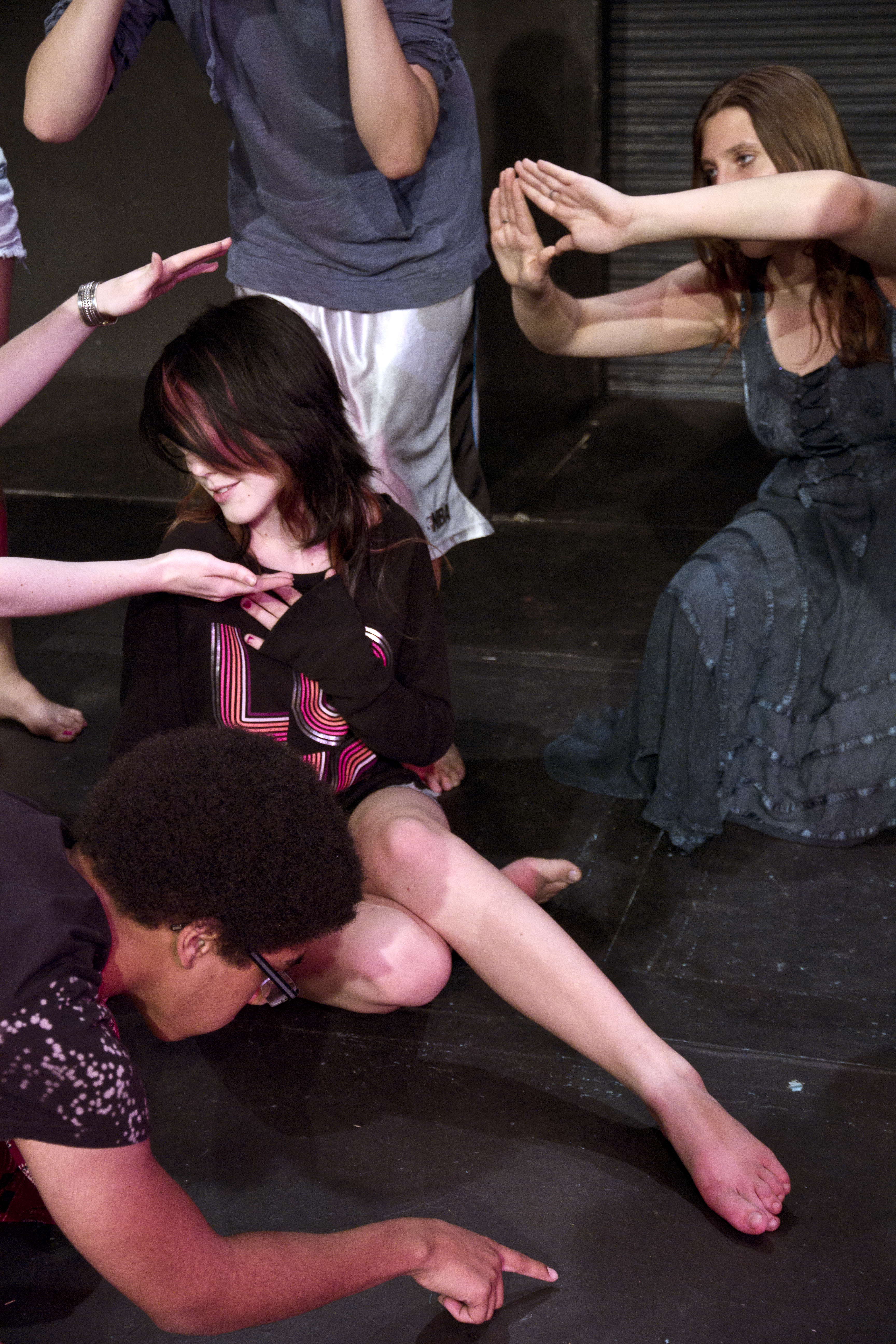by Gwethalyn
In session 4 we knew we were going to lose several participants to a choir concert half way through the session, so we spent a little more time in the movement exercises before the readings than we usually do, for we were working on one of the true staples of our staging techniques, image theater. If ever you are stuck when tying to stage a piece image theater is there to save the day! Using concepts taken from one of our later readings the participants used their group mates and their own bodies to create a static stage image, or tableaux. Each person in the group gets to make their own image of each concept. Our first concept was scandal, this produced a lot of images of peeking or of turning away, or pointing. Our next concept was romance and here we got a lot more variation in the images. Some things were easy to identify, a wedding scene, hand holding, gazing up at someone adored, but we also saw images of striving, denying, clinging, and solitude caused by others’ romance. Our next concept was femininity and here is where things really got interesting. The array of images was astonishing, some people went for the abstract using their group as a whole, some people stood in poses that seemed to exemplify femininity or to reject it. Our last concept was beauty and they really had the hang of it by now, again the images were extremely varied in technique and substance.

This is the first year we have used these concepts, but I think they may have to go into regular rotation because the results were fantastic. As a final step, we all built an image together using pieces of our images for each concept: one big giant collage of an image. I was participating in this game, so I didn’t get to see the final whole group image, but Flinn took some photos – one of which I am including here. I am really looking forward to seeing the rest of those.

In the readings we began with a new author to the workshop, Tawfiq al-Hakim. He was one of the first Egyptian playwrights to find a way to use a formal enough form of Arabic for his plays to be considered literature, but also colloquial enough to accommodate humor and more realistic dialogue for production. We read his full-length play The Tree Climber, which he wrote after returning from a trip to Paris in 1960. The play shows the influences of the Theater of the Absurd (especially Beckett and Ionesco), but al-Hakim has his own brand of absurdity, his characters seem to spout nonsense from the beginning but slowly make more sense as all is revealed. Things do follow a certain kind of logic, but that logic is as absurd as any nonsense the characters might be guilty of and they seem to know this and regard it as inevitable. One of the most fascinating aspects of the play is that time is of great importance, the whole series of events we witness is set off by the main character’s wife being gone for three days, instead of the half hour she usually goes out for, but time does not function in a linear manner at all. Scenes take place simultaneously on the stage with some characters even watching and commenting on their participation in the other scenes going on. It is made very clear that these are not flashbacks or memories, but happening in “real time” for these characters. Throw in a wife who dresses only in green, a stillborn baby for whom the wife knits only green dresses, and a lizard referred to as The Venerable Lady Green who all may or may not be the same entity, a tree which requires the nourishment of an entire human body in order to blossom with four different kinds of fruit, and a dervish who can produce train tickets out of thin air and you have a very interesting mix indeed, one in which the pursuit of understanding in the face of our inevitable inability to do so ultimately leads to violence. Sounds great eh? We thought so.
We then took a look at JoAnne Akalaitis’s Dressed Like an Egg. This theater piece that she produced with Mabou Mines in the 70s, is based on the life and writings of the scandalous French author Collette (now you see where our concepts for the image theater came from). Akalaitis does not present a narrative story, but rather a collage of impressions and feelings inspired for her, by Colette. All of the dialogue is taken from the writings of Colette or works about her, but the words are always spoken as a sort of soundtrack to an image rather than something a character is actually saying. The images are varied and include a liberal use of extremely theatrical conventions such as lights, curtains, and props. In our discussion we talked about how we could still write in the style of Dressed Like An Egg without having access to many of these theatrical conventions. The participants identified how it would be done right away, duh, no problem there.
After the readings we played a game we call quartets. I think you will get the hang of the rules of the game if you just watch this video of some of it. It is a really fun and funny game and one which always puts the participants’ focus to the test as they try to maintain a neutral face throughout. There is still work to be done in this area, but great strides were made in the area of focus, especially since as we were finishing up the band that was to play in the space after our session was over began loading in their equipment. Didn’t even faze them, although sometimes our laughter still did.

Leave a Reply
You must be logged in to post a comment.